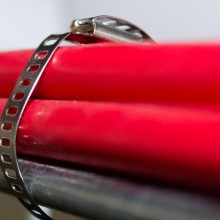Fire Resistant Cables Between Buildings
Unfortunately, it's a question to which there is no straightforward answer as we explain below....

Prysmian are often asked the question which fire performance cable should be used between buildings for fire alarm systems or emergency lighting systems. This is a topic for which there are no specific guidelines in BS 5839-1 Fire Detection and Fire Alarm Systems for Buildings or BS 5266-1 Emergency lighting Code of practice for the emergency lighting of premises, on which cable to select.
BS 7629-1 Electric Cables
It is also worth mentioning that the principal specification to which Prysmian manufacture fire alarm and emergency lighting cables is BS 7629-1 Electric Cables. What's more, Prysmian do not recommend the installation of cables manufactured to BS 7629-1 in buried ducts. That's because these cable's have an aluminium foil screen and this could corrode in permanently wet or semi-wet conditions. From Prysmian's experience, it is almost impossible to exclude water from subterranean ducts, even if they are sealed. Moreover, BS 7629-1 cables are not armoured and therefore do not have intrinsic mechanical protection for buried installations.
Both BS 5839-1 and BS 5266-1 allow for fire resistant armoured cables manufactured to BS 7846 as an alternative cable standard for cables.
Armoured Fire Resistant Cables
Prysmian FP400 and FP600s are armoured fire resistant cables which are suitable for burial in ducts in free-draining soils. Of course, if the soil is not free-draining, or if a duct is already filled with water, then water may eventually permeate through the sheath and corrode the cable's steel wire armour impacting its integrity.
One option for cable between buildings would be to use small diameter Prysmian FP400 or FP600s in an underground duct and then to joint this to conventional BS 7629-1 cables within the building using a fire resistant joint and enclosure. Because the complete assembly uses fire resistant components, it is not necessary for this joint to be positioned at the cable's point of entry to the building.
Non Fire Resistant Armoured Cable
With that in mind, another option would be to run a non-fire resistant armoured cable (to BS 5467/BS 6724) in the underground duct between the buildings. However, because the cable is not fire resistant it must be run directly into a fire resistant enclosure and joint at the entry to the building to connect it to the BS 7629-1 cable, such as Prysmian's FP200 Gold or FP PLUS, otherwise it will jeopardise the integrity of the circuit.
So circuit integrity in the event of fire for a network of buildings will impact on the cable and installation method to choose, for more information see our range of cables.


